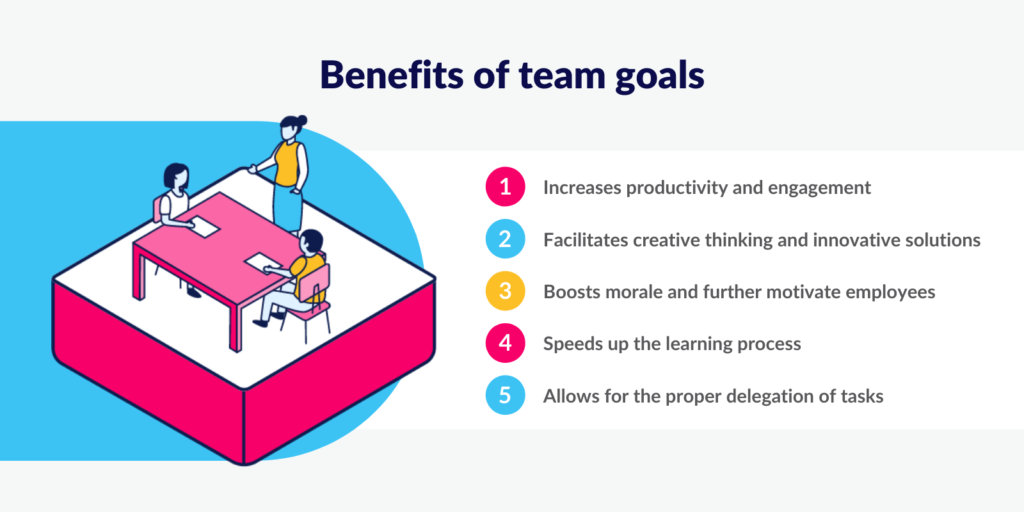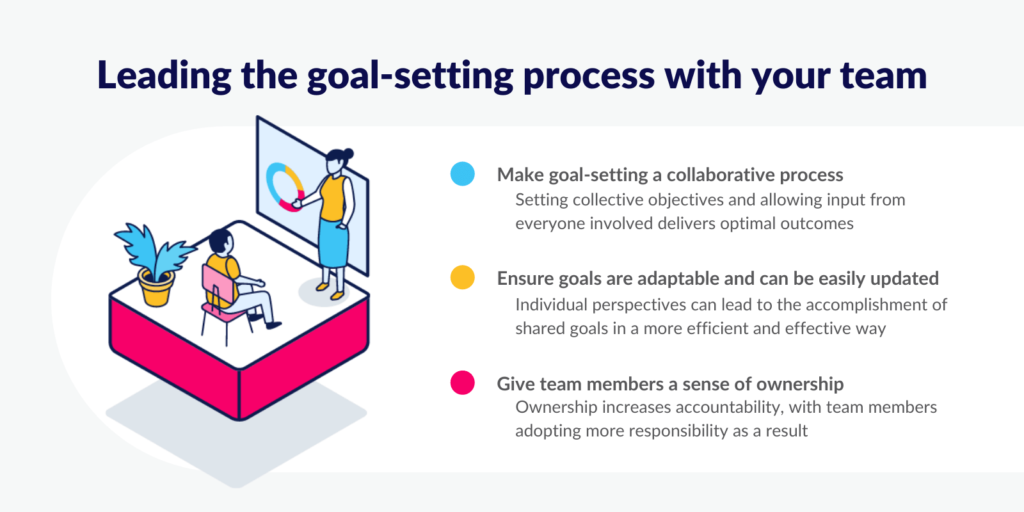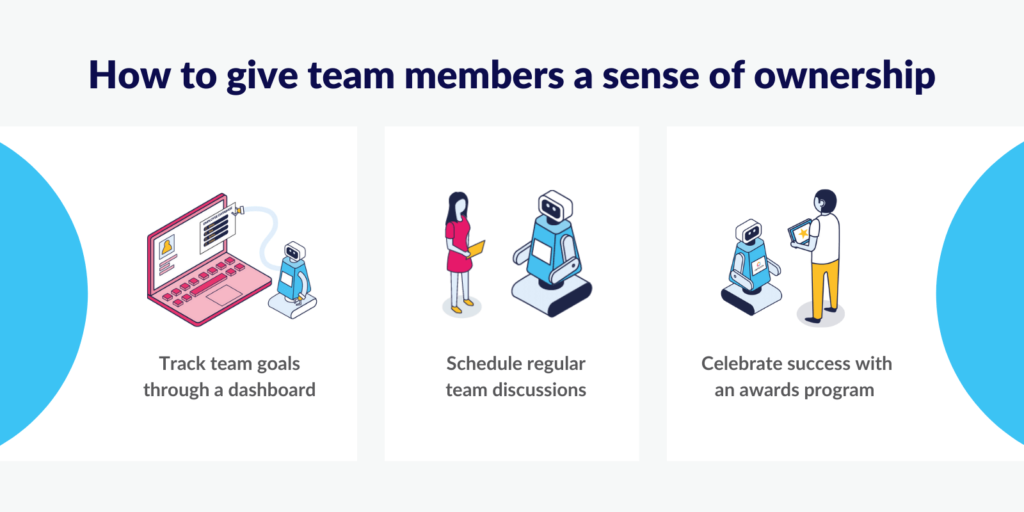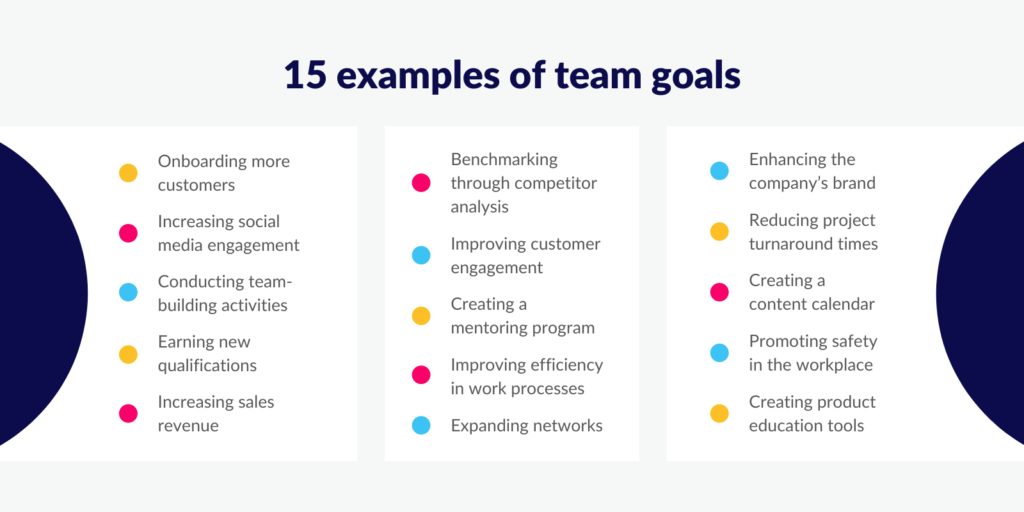Team goals are an important aspect of a company’s goal setting process. They help each team member work more effectively individually and within their department. Understanding how teamwork contributes to broader company goals can be beneficial to productivity and success.
This article will explore the various benefits of team goals and the process to follow when setting objectives for teams. Plus, we’ll provide some actionable examples of clear team goals you can use in your workplace.
What are team goals?
Team goals are the group objectives aimed for by teams and departments which encourage their members to work collaboratively. By setting goals for teams, each employee understands how their role and responsibilities play into the bigger picture. This allows them to understand how their contributions are reflected in overarching company goals and values.
As with individual goals, team goals should be meaningful and attainable. They should make the most of the individual strengths of each employee in a team. Managers who are responsible for setting team goals need to assess the expertise of each team member individually. They then must combine these skills to determine how their department can best work to accomplish targets
Benefits of team goals
There are a range of excellent benefits to be gained from setting team goals. In addition to helping each team member better understand the role they play in group outcomes, team goals can also:
1. Increase productivity and engagement
When teams work together to achieve collective goals, employees need to communicate regularly. This increases levels of productivity and engagement.
This increase in engagement can lead to better business outcomes. A report from Gallup indicates that highly engaged employees can lead to an increase in profitability of up to 21%.
2. Facilitate creative thinking and innovative solutions
Higher engagement levels and stronger communication networks between team members allow for a free flow of new and innovative solutions. When each team member is invested in accomplishing a shared objective, brainstorming conversations are more frequent and productive.
This means opportunities for creative solutions are increased. Different perspectives of each team member work together to develop a much larger pool of ideas. This works great in person, but can also be beneficial in remote and hybrid teams. Company intranets and dedicated channels in Microsoft Teams are a great way of hosting out-of-the-box conversations.

3. Boost morale and further motivate employees
Achieving team goals brings each team member closer to one another. It fosters a sense of camaraderie, enhances social bonds and motivates everyone to deliver their best work. If one team member starts to flag, their colleagues are on hand to step in and motivate them to perform their best.
Teamwork is an effective way to help staff feel a sense of belonging and value to their employer. It creates a support network with mutually shared interests which strengthens bonds and boosts morale.
4. Speed up the learning process
Team members are often required to learn new tools and skills in order to accomplish team goals. When this is the case, each individual has access to a broader pool of talent to help bring them up to speed.
If a team member needs training, coaches and mentors within the team can be allocated. This helps to speed up the learning process, as a reliable source for questions and advice is invaluable.
5. Allow for the proper delegation of tasks
Every member of a team brings a unique set of skills to the table when working towards team goals.
This means tasks can be more effectively delegated to maximise the skill set of each member. Whether this is organisational skills, leadership skills, or processing data; there’s always someone on-hand who can pick up the relevant tasks.
Leading the goal-setting process with your team
When setting team goals, managers and team leaders should approach the task with a mindset that emphasises collaboration, adaptability, and ownership.

Let’s look at these core components of setting team goals in more detail:
Make goal-setting a collaborative process
Involving each team member in the process of setting team goals can aid in achieving company goals.
Setting collective objectives and allowing input from everyone involved delivers optimal outcomes. A study from the Review of Public Personnel Administration, Goal Setting in Teams, explains this dynamic:
“In conditions where team members can exert their influence, there is more control over how set objectives can be achieved and which actions have to be taken to that end. This influence supports the motivational mechanisms of direction, effort, persistence, and strategy, stimulating commitment and self-efficacy. The motivation ensuing from the clarity of the team goals will then be stronger so that team members can obtain better results as a consequence.”

Ensure goals are adaptable and can be easily updated
When team goals are set in stone, employees working towards achieving them can feel constrained. This can lead to missed opportunities to improve processes and outcomes.
By making team goals flexible, each member can make suggestions for improvements. These individual perspectives can lead to the accomplishment of shared goals in a more efficient and effective way.
Give the team members a sense of ownership
When team members feel a sense of ownership for their goals, they become more invested in delivering a positive outcome. Ownership increases accountability, with team members adopting more responsibility as a result.

You can help increase the sense of ownership by:
- Scheduling regular discussions. Encouraging team members to meet to discuss progress helps improve communication. It gives each team member an opportunity to bring attention to any obstacles which need to be overcome.
- Tracking team goals through a dashboard. Using the dashboard reports feature of performance management software allows teams to remain aligned with priorities on a day-to-day basis.
- Implementing an awards program to celebrate successes. Performance management software can also be used for ongoing awards and recognition programs. Encouraging each member to celebrate the successes of their colleagues and improve company culture.
How to set goals: Start SMART
While SMART goals are usually associated with individual targets, they are just as useful when applied to team goals. SMART goals – an acronym for Specific, Measurable, Attainable, Relevant, and Time-bound – deliver a useful framework to ensure goals are worth pursuing.
Team members should be involved in the process of establishing SMART goals to increase their sense of ownership and participation. Team leaders should be forward with their encouragement of such participation to make sure everyone has their say on what goals should be adopted.
Aligning team goals with company goals should be something to bear in mind if you want to place these goals in a broader context. These goals should then be set down as Objectives and Key Results (OKRs). It’s easy to monitor progress across the team using OKR objectives software.
15 examples of team goals
Team goals come in a broad range of types and circumstances. Here are 15 examples of team goals you can use in the workplace:
1. Onboarding more customers
Set basic performance-related goals at the team level. For instance, you could set a target for incrementally increasing customer onboarding over a series of months.
2. Increasing social media engagement
Social media engagement can drive customer acquisition and retention. Teams can work together to formulate strategies to adopt, as well as use A/B testing to iterate campaigns.
3. Conducting team-building activities
Scheduling a specific number of team-building activities per week or month is an often overlooked activity. Setting team goals around teamwork is an effective way to create more cohesive and aligned teams.
4. Earning new qualifications
A given team may require training or new qualifications relating to their job requirements. Allocating this training at the team level gives all participants additional support.
5. Increasing sales revenue
This is an area of goal setting that is commonly used at the individual level. However, a target to increase sales revenue can also be set at the team level. It encourages the group to work together to help improve the performance averages of each team member.
6. Benchmarking through competitor analysis
Benchmarking competitor performance requires the collection and analysis of various metrics. It’s a time-consuming and never-ending task, so can be undertaken more regularly when set as a team goal.
7. Improving customer engagement
This is an effective target for both sales and support teams. Improving customer engagement is a team goal that is easily measured and tracked through performance management tools.
8. Creating a mentoring program
Identifying team members who have unique skills to share can help establish mentoring programs. Mentoring aids personal and team development, which can be monitored through team goals.
9. Improving efficiency in work processes
This is another goal that is effective at both the individual and team level. For instance, setting goals through process mapping. This allows teams to view work processes and collectively decide on ways to improve them.
10. Expanding networks
Team members can achieve goals by attending networking events to expand their industry contacts. Allocating a specific number of events within an allotted time frame will grow your potential customer base.
11. Enhancing the company’s brand
Team goals related to improving how the outward perception of the company can be applied to many departments. While sales and marketing may have specific ideas, other teams may be able to improve company perception in some fresh and exciting ways.
12. Reducing project turnaround times
Setting a shared goal for teams to reduce project turnaround times will encourage collaboration and out-of-the-box thinking. Each team member approaches challenges with their own unique perspective, and every part streamlined leads to more efficiency company-wide.
13. Creating and implementing a content calendar
An effective team goal for marketing teams, creating and implementing a content calendar requires everyone to work together. This involves working on the creation of content, distributing it and tracking return once content is live.
14. Promoting safety in the workplace
Each individual in a team has their own approach to risk assessment. Assigning a team goal to promote safety in the workplace will ensure a broader range of ideas is explored. This ensures that everyone is up-to-date with existing policies while offering the opportunity for improvements.
15. Creating product education tools for clients
Across a company, there are various individuals involved in the design of products and services. Creating effective product education tools for clients and prospects works well as a collective effort. Inter-departmental goals can really bring a company together and improve workplace culture.

In summary
With team goals known to help improve engagement, productivity, and levels of motivation, getting them right is crucial. This guide should help you to set team goals that align team members to the task at hand, delivering the best outcomes for your business.





